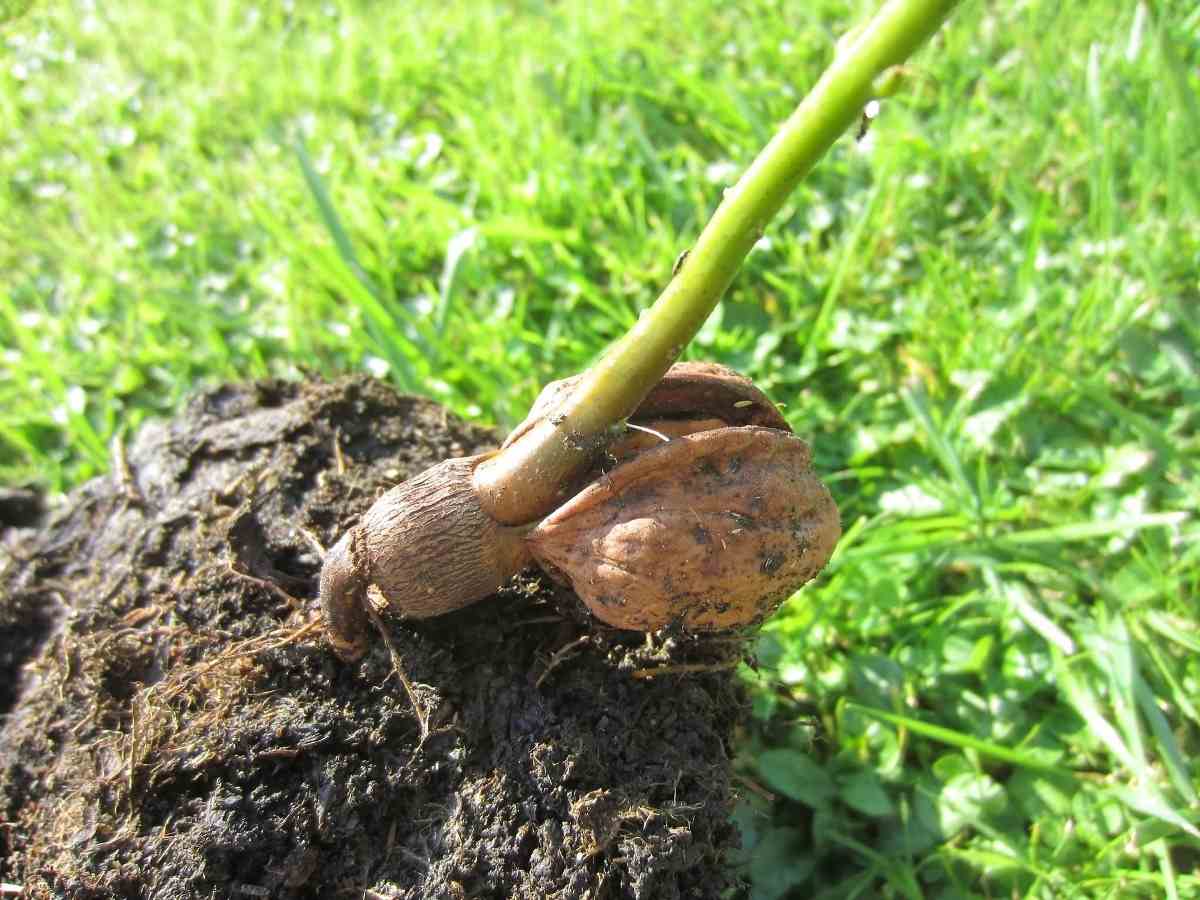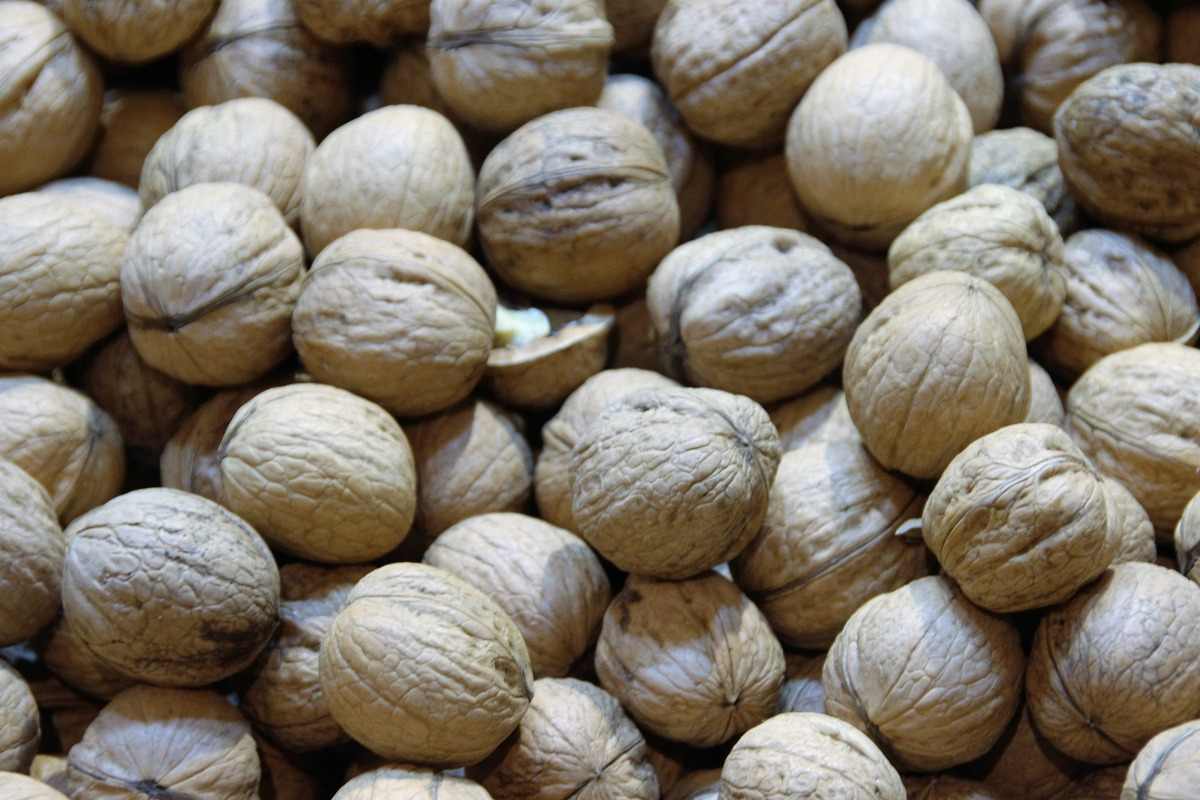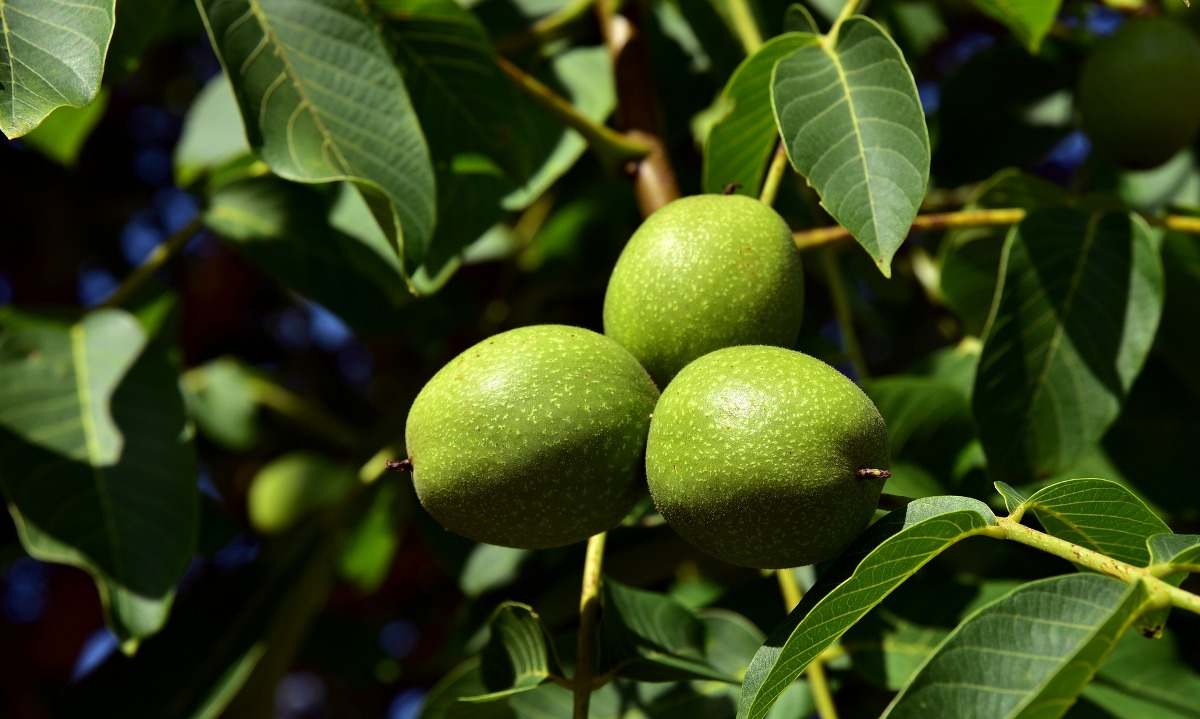Introduction to Walnut seed germination
Walnuts are fast-growing trees that develop broad canopies reaching 18 meters wide and 30 meters in height. Walnut is a light-demanding species, requiring full sun to grow well. Walnut trees belong to the genus Juglans, which includes about 20 species grown for their edible nuts and attractive foliage. Walnut (Juglans sp.) is the important temperate nut fruit of the country. Walnut in India is found in different sizes and different shapes. The Indian Walnuts are categorized into 4 categories that are paper-shelled, thin-shelled, medium-shelled, and hard-shelled. Walnut is an important temperate nut crop with delicious kernel and it belongs to the family Juglandaceae and genus Juglans. In this article we also discussed below topics;
- How do you germinate Walnuts
- Walnut seed germination temperature
- How do you germinate Walnut seeds
- How long do Walnut seeds take to germinate
- Process for germinating Walnut seeds
- Walnut germination period
A step by step guide to Walnut seed germination
Walnut trees can produce flavorful nuts and durable, attractive timber, but home gardeners must be aware that they often kill nearby plants. Also, keep in mind that trees don’t start producing nuts until about 10 years after they have been planted and the nut production will peak at about 30 years after planting.
Soil and location for Walnut cultivation
The best locations for Walnut trees are sunny, and relatively sheltered sites. The ideal soil is a deep, fertile, well-drained loam with a pH level between 6 and 7 (4.3 – 8.3 tolerated), although growing in heavy clay on the river banks and trees tolerating a wide range of soil conditions.
Walnut tree propagation
Walnut trees commonly reproduce in the wild and are easy to grow from seed. A tree grown from seed will start to produce fruit in 8 to 12 years, it’s not certain that it will share the characteristics of the parent trees. Walnut cultivars are grafted and start to fruit in the fifth year. Seeing as most cultivars are 2 years old when you buy them, the trees can start to bear fruit in the 3rd year after planting.
The spacing of Walnut trees
Proper spacing mainly depends on whether trees are being grown for nut production or timber products. For timber production, no fewer than 300 trees per acre (12 feet by 12 feet) must be planted. A 10-foot by 10-foot spacing provides about 436 trees per acre. Spacing less than 10 feet by 10 feet will provide even more trees to select from when selecting crop trees, which will increase growth and stem quality, shortening the time it takes for canopy closure and reducing the period required for weed and grass control.
Conditions for germination of Walnut seed
In case if you miss this: Drip Irrigation for Vegetables.

Walnut trees can be easily grown from seeds by following steps;
- First, collect Walnuts after they fall to the ground. Remove the husks and place the nuts in water. Nuts that float are not viable and could be discarded. Good and viable nuts will sink to the bottom.
- Before the Walnuts will germinate, the nuts need to be exposed to cold temperature ranges and moist conditions. The cold-moist requirement can be met by planting the nuts in the ground in fall and plant Walnuts 1 to 2 inches deep.
- The cold-moist requirement can be accomplished through a process called stratification. Walnuts can be stratified by placing the nuts in a moist mixture of sand and peat moss and storing them in a cool location. Suitable containers contain coffee cans, plastic buckets, and food storage bags. Then, the refrigerator is a good storage location. Stratification temperatures must be just above freezing. The Walnuts should remain in the refrigerator for 90 to 120 days. After the nuts have been properly stratified, and they can be removed from the refrigerator and planted.
Requirements to plant the Walnut seeds
Seeds can be planted early in the fall so that the necessary chilling occurs naturally, or they can be planted in the spring if they are fully stratified. Improper stratification or dry soil can delay germination until the second year. Fully stratified seeds can be taken out of cold storage about 1 week before planting to accelerate seed germination. Make sure they do not dry out and handle seeds carefully to protect the emerging radicals.
Plant each Walnut seed about 2 to 3 inches deep with the nut laying on its side. If more than one seed is planted per seed spot, put them at least 8 inches apart to make it easier to remove excess seedlings at a later date. If you plan to strip spray with herbicides in the future, and plant nuts within a seed spot in a single file parallel to the rows. If you plan to spot spray, use a triangular pattern for 3 seeds or a square pattern for four seeds within each seed spot. Using clustered patterns helps to keep rows straight, minimize the size of herbicide circles, and minimize the number of materials required if you erect mechanical barriers to predation.
Protect Walnut seeds from squirrels and other predators by using mechanical barriers or chemical repellents. The cheapest and effective repellent is a generous portion of fresh cow manure over each seed spot.
The process of Walnut seed germination
You should not miss this: Flaxseed Germination, Temperature, Process.

- Non-hybrid varieties of Walnut trees grow reliably well from seed, which should be removed from the husk and sown while still fresh. The seeds germinate rapidly once exposed to warm conditions, although they should be chilled before sowing to break their dormancy. Gather Walnut seeds in late autumn after the rubbery husks ripen to a bright, yellowish-green color. Collect the fruit from the ground and avoid any fruit with obvious signs of insect or vermin damage, such as large holes and black spots.
- Put on thick gloves before working with Walnuts, since the husks will stain your skin. Then, remove the husk from each seed by scoring it lightly around the outside with a utility knife. Pry off the husk and discard it. Place the husked Walnut seeds in a bucket of water. Soak them overnight to determine which are viable and discard any Walnuts that float to the surface. Sow the Walnuts that sink to the bottom.
- Place the Walnuts in a 2-gallon sealable plastic storage bag filled with moistened perlite. Then, press them into the perlite until they are covered completely. Store the bag in the refrigerator for 3 to 4 months and remoisten the perlite whenever it feels barely damp. Prepare containers for the Walnut seeds after the cold stratification period has ended. Then, fill 1-gallon nursery containers with a mixture of equal parts compost, potting soil, and coarse sand. Add water until the mixture feels moist in the top 5 inches.
- Sow one Walnut seed in each pot at a depth of 1 to 2 inches. Then, set the pots inside a ventilated cold frame or outdoors against a south-facing wall. Select a spot offering light shade during the hottest part of the day.
- Keep the soil mixture consistently moist in the top about 3 inches during the germination procedure. Water whenever the soil dries out slightly in the top inch and never let the soil dry out completely. Warm the pots to between 21 and 29°C if daytime temperatures stay below 18°C. Then, use a germination mat or a greenhouse heating coil. Turn off the heating element at night.
- Watch for the first seedlings in 4 to 6 weeks. Turn off the heating element once seedlings emerge and move the black Walnut seedlings to a sheltered, lightly shaded area outdoors. Acclimate the Walnuts to direct sun over one week. Grow them in full sun during the summer months, but give light shade during the hottest part of the day if growing them in a hot, dry inland area. Provide 1 inch of water weekly.
- Walnut trees grow readily from fresh seeds, which need little hands-on care if thoroughly cleaned before sowing.
Days have taken for Walnut seed germination
The combined application of different pre-sowing treatments resulted in minimum days taken for seed germination. Seeds of Walnut showed early seed germination (12 days) when a combination of cracking with GA3 (Gibberellic acid) by 750 ppm stratification for 30 days than control and single treatments. Early germination might be because Gibberellic acid plays an important role in two stages of germination one at initial enzyme induction and other inactivation of reserve food mobilizing system which helps in the enhancement of seed germination. The maximum days taken for seed germination (76 days) were recorded with control treatment.
Walnut seed germination temperature
Walnut seeds require a certain temperature to germinate. Each plant has a specific optimum and a range within which seed germination will occur. The closer the temperature range is to optimum the quicker germination will occur. The seeds germinate rapidly once exposed to warm conditions and 29°C if daytime temperatures stay below 18°C.
Seed germination percentage of Walnut
The combined application of different pre-sowing treatments resulted in minimum days taken for germination and maximum germination. Seeds of Walnut showed early germination (12.68 days) as well as best germination (75.68%) when a combination of nut-cracking with GA3 by 750 ppm stratification for 60 days and combination of nut-cracking with GA3 by 500 ppm for 60 days stratification were used respectively as compared to control and single treatments. The maximum germination might be because GA3 mainly involved in the activation of cytological enzymes which stimulates α – amylase enzyme that converts insoluble starch into soluble sugars and early germination might be because GA3 plays an important role in two stages of seed germination one at initial enzyme induction and other inactivation of reserve food mobilizing system which helps in enhancement of seed germination.
Gibberellic acid was required in relatively lower concentrations with stratification and scarification for the maximum germination. The inability of Walnut seeds to germinate can be due to the presence of a hard seed coat. As the scarification treatment given to the seed helped in water uptake, growth hormones, and air which is essential for germination. Prechilling stratification had a significant effect on breaking of seed dormancy and it can be attributed that at low temperature more oxygen dissolves in water and therefore more oxygen is available for an embryo.
Care for Walnut trees from seeds
- The seeds germinate rapidly and will be ready for transplant in about one year, although they should be cold stratified before sowing to improve their germination rate. Then, collect Walnut seeds in mid- to late autumn after the fruit has fully ripened. And wait until the husks have darkened and begun to split open, revealing the wrinkled brown nut.
- Gather several Walnut fruits from the ground and inspect them closely for signs of insect holes, mold, or rodent damage. Avoid Walnuts with obvious damage as they are probably hollow or otherwise not viable. Then, put on rubber or leather gloves while processing the Walnuts because their husks will discolor your skin. Peel off the husks and discard them. Put the husked Walnuts into a bucket.
- Fill the bucket half-full with water and soak the Walnuts overnight or at least for several hours to determine if any are viable. Discard the nuts that float to the surface and keep those that sink. Then, fill a clean coffee can with a moistened mixture of half coarse sand and half perlite. Bury the Walnuts about 2 inches deep in the sand. Store the container inside the refrigerator for roughly 4 months. Remoisten the sand mixture, as needed.
- Prepare a growing container for each Walnut. Fill about 12-inch greenhouse pots with a mix of half loam and half sand. Leave the top inch empty. Sow one Walnut in each greenhouse pot at a depth of about 2 inches. Put the pots inside a cold frame or against a lightly shaded, south-facing wall. Warm the seeds to 85 degrees Fahrenheit during the day using the propagation mat and turn off the mat at night.
- Check the moisture content of the soil every day by sticking a finger into the top few inches. Water to about 4-inch depth whenever the soil feels mostly dry in the top inch. Avoid letting the soil dry out completely because the Walnuts can re-enter dormancy. Watch for the first emergent Walnut seedlings in approximately one month. Remove the propagation mat and crack open the cold frame once the Walnut seeds germinate. Then, continue to water to a 4-inch depth whenever the soil dries out in the top inch.
- Move the pots to a sheltered area outdoors once the Walnut seedlings produce a set of mature plant leaves. Grow them in full sun with about 1 inch of water each week during their first summer. Then, transplant the immature Walnut trees into a permanent bed in early autumn just after the first rainfall. Plant them in a sunny bed with moist, fast-draining soil.
Commonly asked questions about Walnut farming
You may also check this: Vertical Herb Farming, Advantages, Ideas, and Tips.

Can you plant a Walnut from the store?
To successfully germinate and grow, Walnuts need stratification or a period of cold temperature. After purchasing the whole Walnuts from the grocery store, and then soak the nuts in water overnight. In the spring season, plant the Walnuts in the ground or pots with good quality potting soil.
How long does it take for Walnut seeds to germinate?
About 12 to 15 weeks later, some seeds will have normally sprouted. We plant them directly in the field (in areas with mild winters) or in individual pots containing special soil mix that means soil with river sand and compost etc.
How fast does a Walnut tree grow?
According to timber experts, black Walnut trees, when planted to maximize tree growth, can grow as much as 3 to 4 feet per year in good soil, reaching a mature height of over 100 feet and 30 to 40 inches in diameter, with 16 inches diameter nuts ready to harvest in 30 years.
How many Walnuts does a Walnut tree produce?
Nut production continues to increase until 20 years of age and trees are grown for nuts and timber. A Walnut orchard can take a few years to come into full production but then produces up to about 6,000 pounds per acre.
Do Walnut trees produce Walnuts every year?
Walnut trees are capable of producing nuts every year, but you can experience patterns of high and low yields from year to year.
In case if you are interested in How to Make Money from an Organic Farming Business.
We harvested walnuts in Frist week of August 2022,stored the in empty cement bag.when after two weeks we removed husk,I was surprised to see some of the nuts supruts.I sowed those those whose s redicals were in condition and got seedlings about 10 in numer todi on 18/09/2022 without any stratification.So stratification is not a must to raise walnuts from fresh nuts in August/September.